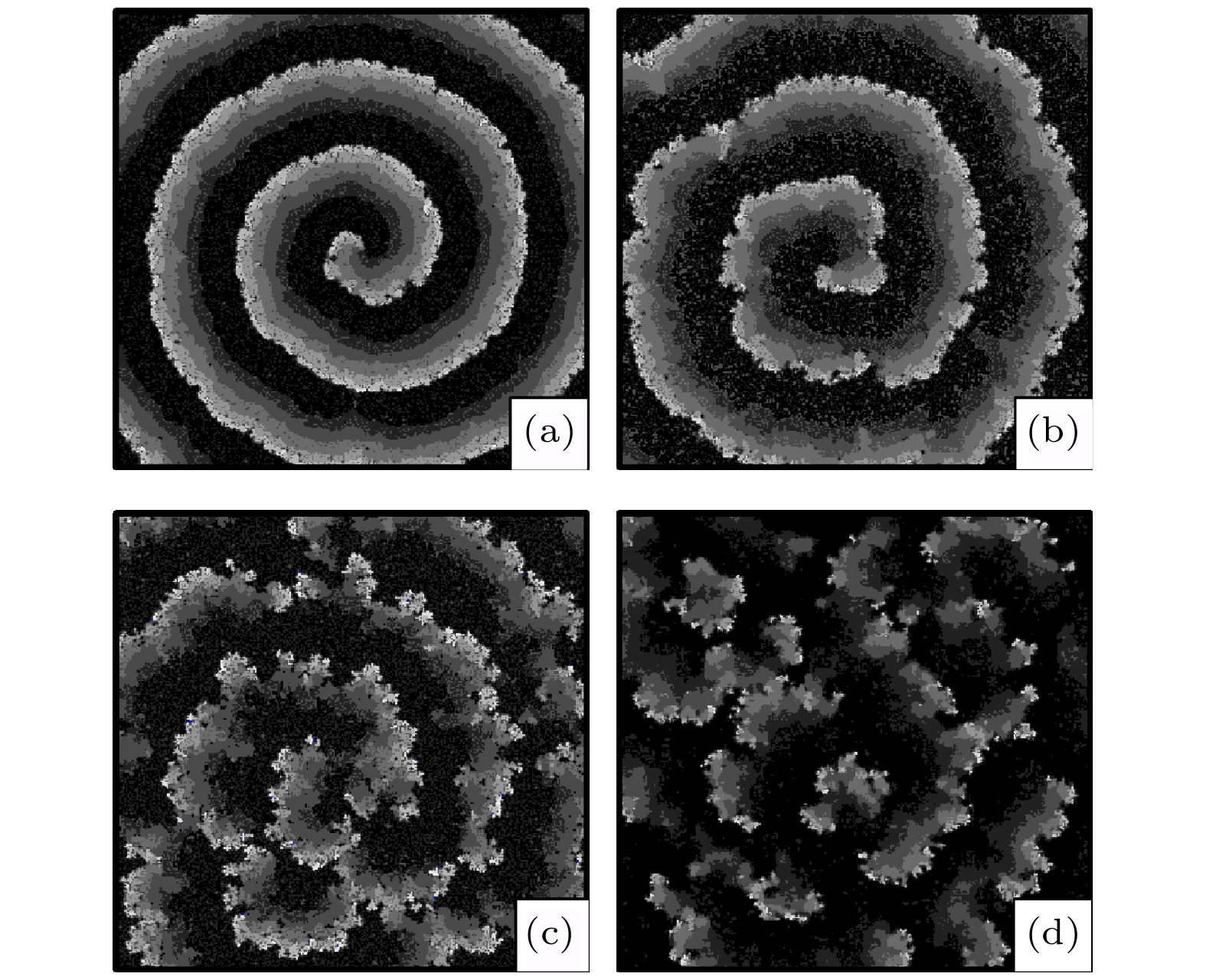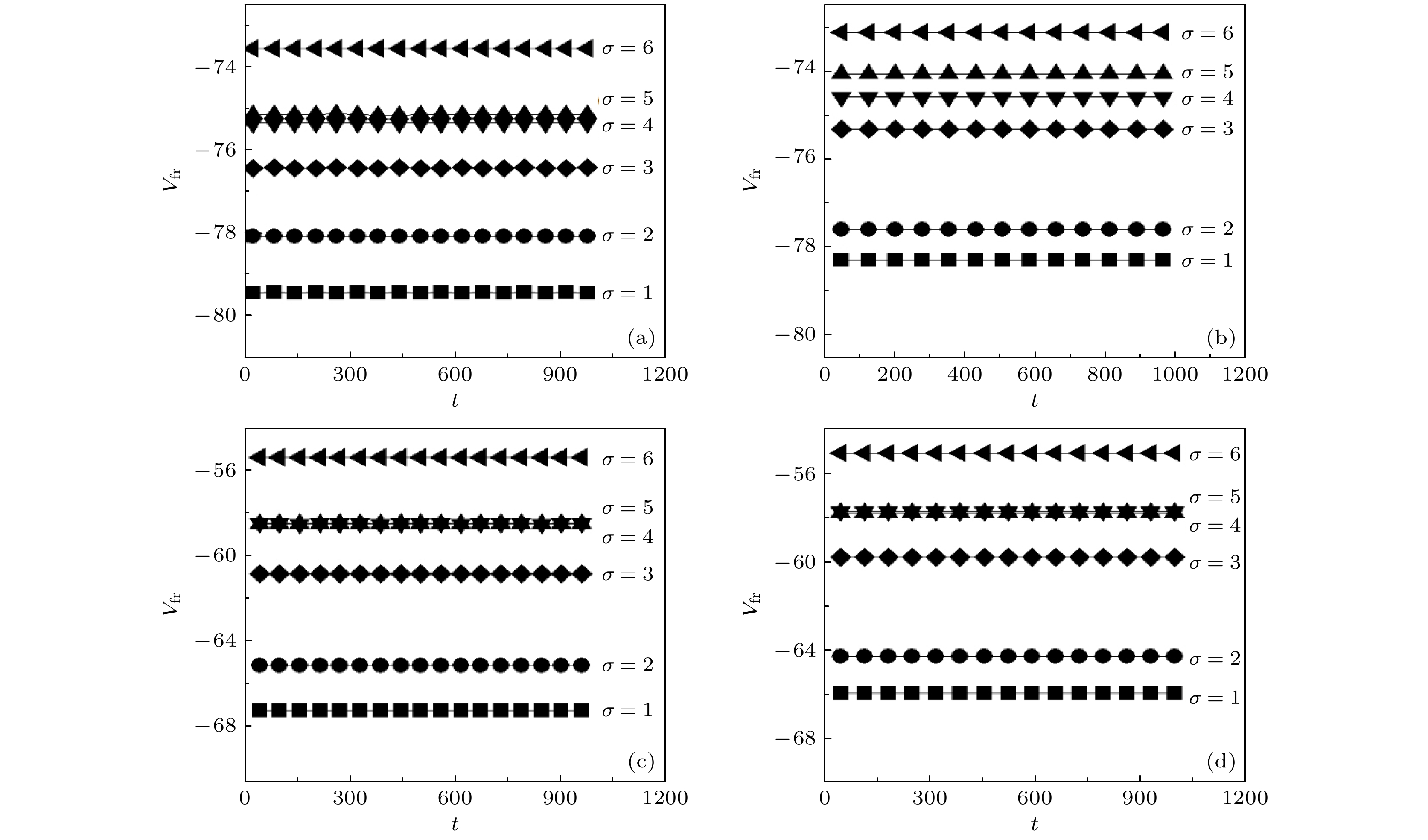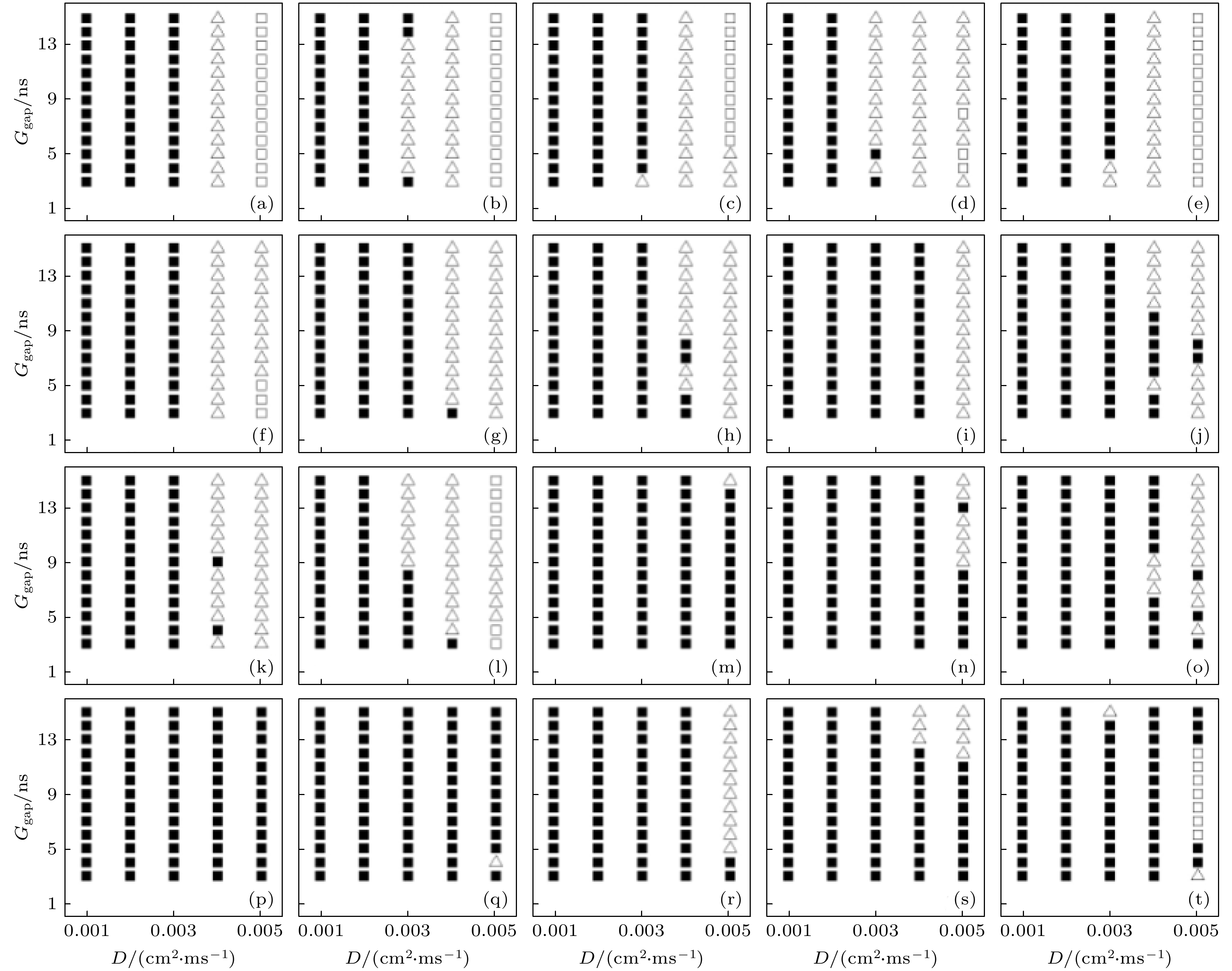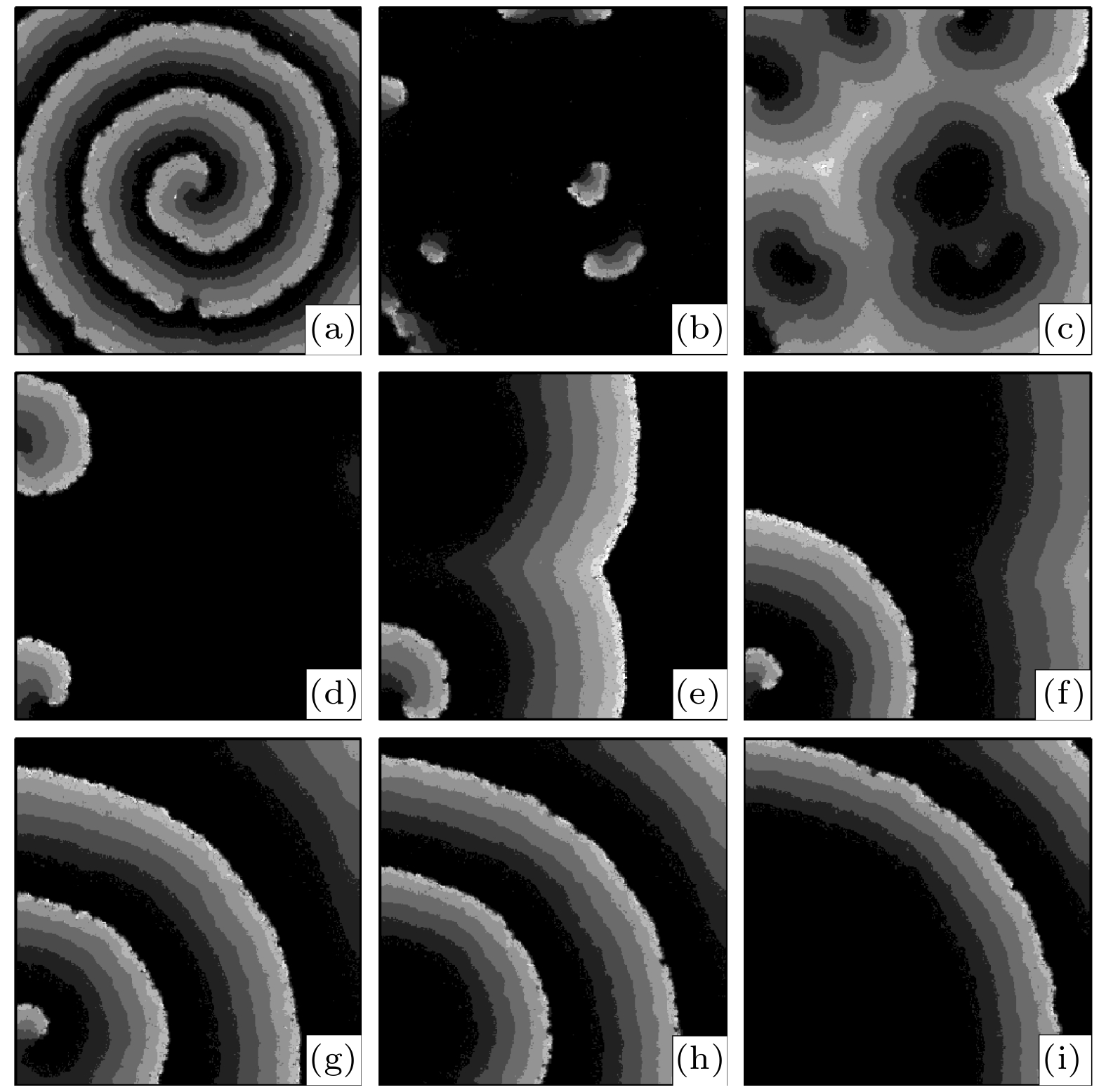-
心脏出现电螺旋波和时空混沌会导致心律失常, 心肌细胞与成纤维细胞电耦合(M-F耦合)导致心肌组织结构改变也会引起心律失常, 如何消除由螺旋波、时空混沌导致的心律失常是科学工作者十分关注的问题. 本文构造了由心肌细胞和成纤维细胞组成的双层复合介质, 采用Luo-Rudy相I心脏模型及被动成纤维细胞模型研究了M-F耦合对螺旋波形成的影响, 以及螺旋波和时空混沌的控制, 提出用提高细胞之间的耦合强度来控制复合介质中的螺旋波和时空混沌, 数值模拟结果表明: M-F耦合对螺旋波动力学有重要影响, 随着成纤维细胞密度的增加, M-F耦合会导致螺旋波漫游和破碎成时空混沌, 甚至会产生从时空混沌(或螺旋波)到无波的相变. 通过提高细胞之间耦合强度来消除复合介质中的螺旋波和时空混沌, 只在大部分情况下有效, 依赖于成纤维细胞所起的作用. 当成纤维细胞起到电流吸收器的作用时, 虽然大部分情况下可以通过提高细胞之间耦合强度来消除螺旋波和时空混沌, 但是可控区较小. 当成纤维细胞起到电流源的作用时, 提高细胞之间耦合强度使之超过临界值基本都可以有效控制螺旋波和时空混沌, 且可控区比前者大为增加, 提高控制效果的关键是提高心肌细胞之间的耦合强度.
-
关键词:
- 螺旋波 /
- 时空混沌 /
- 心肌细胞与成纤维细胞电耦合 /
- 控制
Cardiac arrhythmias can be caused by the occurrence of electrical spiral waves and spatiotemporal chaos in the cardiac tissues, as well as by the changes of cardiac tissues resulting from the electrical coupling of cardiomyocytes to fibroblasts (M-F coupling). How to control the arrhythmia induced by spiral wave or spatiotemporal chaos is the problem which has attracted much attention of scientists. In this paper, a two-layer composite medium is constructed by using cardiomyocytes and fibroblasts. Luo-Rudy phase I cardiac model and passive model of fibroblast are used to study the effects of the M-F coupling on the formation of spiral wave and the control of spiral wave and spatiotemporal chaos in a two-layer composite medium. A control scheme that the spiral waves and spatiotemporal chaos are controlled by increasing the coupling strength between cells is proposed. The numerical results show that the M-F coupling has an important influence on the dynamics of spiral wave. With the increase of the density of fibroblasts, the M-F coupling may result in spiral wave meandering and spiral wave breaking into spatiotemporal chaos, and even induce the transition from spatiotemporal chaos (or spiral wave) to no wave. The eliminating spiral wave and spatiotemporal chaos in the composite medium by increasing the coupling strength between cells is only effective in most of cases, depending on the role played by fibroblasts. When fibroblasts act as current sinks for the cardiomyocyte, the spiral wave and spatiotemporal chaos are effectively eliminated only in most of cases by increasing the coupling strength between cells, and the controlled area is small. When fibroblasts act as a current source for the cardiomyocyte, increasing the coupling strength between cells to a value higher than a critical value can effectively terminate spiral wave and spatiotemporal chaos, and the controllable area is greatly increased compared with the former. Increasing the coupling strength between cardiomyocytes is a key factor in controlling the spiral waves and spatiotemporal chaos.-
Keywords:
- spiral wave /
- spatiotemporal chaos /
- electrical coupling of cardiomyocytes to fibroblasts /
- control
[1] Johnson R D, Camelliti P 2018 Int. J. Mol. Sci. 19 866
 Google Scholar
Google Scholar
[2] Camelliti P, Borg T K, Kohl P 2005 Cardiovasc. Res. 65 40
 Google Scholar
Google Scholar
[3] Greisas A, Zlochiver S 2016 Cardiovasc. Eng. Techn. 7 290
 Google Scholar
Google Scholar
[4] Sachse F B, Moreno A P, Abildskov J A 2008 Ann. Biomed. Eng. 36 41
 Google Scholar
Google Scholar
[5] Peters N S, Wit A L 1998 Circulation 97 1746
 Google Scholar
Google Scholar
[6] Jacquemet V, Henriquez C S 2008 Am. J. Physiol. Heart Circ. Physiol. 294 H2040
 Google Scholar
Google Scholar
[7] Xie Y F, Garfinkel A, Weiss J N, Qu Z L 2009 Am. J. Physiol. Heart Circ. Physiol. 297 H775
 Google Scholar
Google Scholar
[8] Nguyen T P, Xie Y F, Garfinkel A, Qu Z L, Weiss J N 2012 Cardiovasc. Res. 93 242
 Google Scholar
Google Scholar
[9] Brown T R, Krogh-Madsen T, Christini D J 2015 BioMed. Res. Int. 2015 465714
 Google Scholar
Google Scholar
[10] Chilton L, Giles W R, Smith G L 2007 J. Physi. 583 225
 Google Scholar
Google Scholar
[11] Louault C, Benamer N, Faivre J F, Potreau D, Bescond J 2008 BBA-Biomembranes 1778 2097
 Google Scholar
Google Scholar
[12] Vasquez C, Mohandas P, Louie K L, Benamer N, Bapat A C, Morley G E 2010 Circulation Research 107 1011
 Google Scholar
Google Scholar
[13] Baudino T A, McFadden A, Fix C, Hastings J, Price R, Borg T K 2008 Microsc. Microanal. 14 117
 Google Scholar
Google Scholar
[14] Shajahan T K, Nayak A R, Pandit R 2009 Plos One 4 e4738
 Google Scholar
Google Scholar
[15] Nayak A R, Shajahan T K, Panfilov A V, Pandit R 2013 Plos One 8 e72950
 Google Scholar
Google Scholar
[16] Kofron C M, Kim T Y, King M E, Xie A, Feng F, Park E, Qu Z, Choi B R, Mende U 2017 Am. J. Physiol. Heart Circ. Physiol. 313 H810
 Google Scholar
Google Scholar
[17] Kohl P, Camelliti P, Burton F L, Smith G L 2005 J. Electrocardiol 38 45
 Google Scholar
Google Scholar
[18] Luo C H, Rudy Y 1991 Circ. Res. 68 1501
 Google Scholar
Google Scholar
-
图 1 不同参数下在
$\rho \text{-} n$ 参数平面上的相图(■代表稳定螺旋波; ●代表漫游单螺旋波; ◆代表不稳定螺旋波; ▼代表时空混沌态; ▲代表介质无波) (a)$ {G}_{\rm{f}}=1\;{\rm{ns}}$ ,${G}_{\rm{gap}}= $ $ 3\;{\rm{ns}}$ ; (b)$ {G}_{\rm{f}}=4\;{\rm{ns}}$ ,$ {G}_{\rm{gap}}=1\;{\rm{ns}}$ Fig. 1. Phase diagrams on the
$\rho \text{-} n$ parameter plane with different parameters: (a)$ {G}_{\rm{f}}=1\;{\rm{ns}}$ ,$ {G}_{\rm{gap}}=3\;{\rm{ns}}$ ; (b)${G}_{\rm{f}}= $ $ 4\;{\rm{ns}}$ ,$ {G}_{\rm{gap}}=1\;{\rm{ns}}$ . Black square, stable spiral wave; black circle, meandering of single spiral wave; black rhombus, unstable spiral wave; black down-triangle, spatiotemporal chaos; black up-triangle, no wave can propagate in the medium.图 2 不同参数下其中一层心肌层的螺旋波斑图 (a)
${G}_{\rm{f}}= $ $ 4\;{\rm{ns}}$ ,$ {G}_{\rm{gap}}=1\;{\rm{ns}}$ ,$\rho = 20{\text{%}}$ ,$n = {\rm{1}}$ ; (b)$ {G}_{\rm{f}}=4\;{\rm{ns}}$ ,$ {G}_{\rm{gap}}=1\;{\rm{ns}}$ ,$\rho = 30{\text{%}}$ ,$n = {\rm{3}}$ ; (c)$ {G}_{\rm{f}}=4\;{\rm{ns}}$ ,$ {G}_{\rm{gap}}=1\;{\rm{ns}}$ ,$\rho = 40{\text{%}}$ ,$n = {\rm{2}}$ ; (d)$ {G}_{\rm{f}}= $ $ 1\;{\rm{ns}}$ ,$ {G}_{\rm{gap}}=3\;{\rm{ns}}$ ,$\rho = {\rm{4}}0{\text{%}}$ ,$n = $ 4Fig. 2. Pattern of spiral wave in one layer cardiac tissue for different parameters: (a)
$ {G}_{\rm{f}}=4\;{\rm{ns}}$ ,$ {G}_{\rm{gap}}=1\;{\rm{ns}}$ ,$\rho = 20{\text{%}}$ ,$n = {\rm{1}}$ ; (b)$ {G}_{\rm{f}}=4\;{\rm{ns}}$ ,$ {G}_{\rm{gap}}=1\;{\rm{ns}}$ ,$\rho = 30{\text{%}}$ ,$n = {\rm{3}}$ ; (c)${G}_{\rm{f}}= 4\;{\rm{ns}}$ ,$ {G}_{\rm{gap}}=1\;{\rm{ns}}$ ,$\rho = 40{\text{%}}$ ,$n = {\rm{2}}$ ; (d)${G}_{\rm{f}}= $ $ 1 \;{\rm{ns}}$ ,$ {G}_{\rm{gap}}=3\;{\rm{ns}}$ ,$\rho = {\rm{4}}0{\text{%}}$ ,$n = {\rm{4}}$ .图 3 不同参数下成纤维细胞静息电位随时间变化 (a)
${G_{\rm{f}}} = 1\;{\rm{ns}}$ ,${G_{{\rm{gap}}}} = 3\;{\rm{ns}}$ ,$n = 2$ ,$\rho = 30{\text{%}}$ ; (b)${G_{\rm{f}}} = 1\;{\rm{ns}}$ ,${G_{{\rm{gap}}}} = 3\;{\rm{ns}}$ ,$n = 5$ ,$\rho = 30{\text{%}}$ ; (c)${G_{\rm{f}}} = 4\;{\rm{ns}}$ ,${G_{{\rm{gap}}}} = 1\;{\rm{ns}}$ ,$n = 2$ ,$\rho = 30{\text{%}}$ ; (d)${G_{\rm{f}}} = 4\;{\rm{ns}}$ ,${G_{{\rm{gap}}}} = 1\;{\rm{ns}}$ ,$n = 5$ ,$\rho = 30{\text{%}}$ Fig. 3. Evolution of the resting potential of a fibroblast for different control parameters: (a)
${G_{\rm{f}}} = 1\;{\rm{ns}}$ ,${G_{{\rm{gap}}}} = 3\;{\rm{ns}}$ ,$n = 2$ ,$\rho = 30{\text{%}}$ ; (b)${G_{\rm{f}}} = 1\;{\rm{ns}}$ ,${G_{{\rm{gap}}}} = 3\;{\rm{ns}}$ ,$n = 5$ ,$\rho = 30{\text{%}}$ ; (c)${G_{\rm{f}}} = 4\;{\rm{ns}}$ ,${G_{{\rm{gap}}}} = 1\;{\rm{ns}}$ ,$n = 2$ ,$\rho = 30{\text{%}}$ ; (d)${G_{\rm{f}}} = 4\;{\rm{ns}}$ ,${G_{{\rm{gap}}}} = 1\;{\rm{ns}}$ ,$n = 5$ ,$\rho = 30{\text{%}}$ .图 4 与图1(a)对应的各初态下在
$D \text{-} {G_{{\rm{gap}}}}$ 参数平面上的相图, 其中, 第1行到第4行各图参数分别对应$\rho = $ 10%, 20%, 30%, 40%; 第1列到第5列各图参数分别对应$n = 1, \;2, \;3, \;4, \;5$ ; ■代表不可控, Δ代表慢可控, □代表快可控Fig. 4. Phase diagram in the
$D \text{-} {G_{{\rm{gap}}}}$ parameter plane for different initial states showed in Fig. 1(a). The parameter$\rho $ of the panels from the first row to the fourth row equals to 10%, 20%, 30%, 40%, respectively. The parameter$n$ of the panels from the first column to the fifth column equals to 1, 2, 3, 4, 5, respectively. Black and hollow squares represent the uncontrolled point and fast control point, respectively. Hollow up-triangle represents the slow control point.图 5 与图1(b) 对应的各初态下在
$D \text{-} {G_{{\rm{gap}}}}$ 参数平面上的相图, 其中, 第1行到第4行各图参数分别对应$\rho =$ 10%, 20%, 30%, 40%; 第1列到第5列各图参数分别对应$n = 1, \;2, \;3, \;4, \;5$ ; ■代表不可控, Δ代表慢可控, □代表快可控Fig. 5. Phase diagram in the
$D \text{-} {G_{{\rm{gap}}}}$ parameter plane for different initial states showed in Fig. 1(b). The parameter$\rho $ of the panels from the first row to the fourth row equals to 10%, 20%, 30%, 40%, respectively. The parameter$n$ of the panels from the first column row to the fifth column equals to 1, 2, 3, 4, 5, respectively. Black and hollow squares represent the uncontrolled point and fast control point, respectively. Hollow up-triangle represents the slow control point.图 6 在不同的初态斑图和控制参数下平均膜电位差随时间的变化 (a)初态为图2(b),
$D = 0{\rm{.004}}\;{\rm{c}}{{\rm{m}}^2}/{\rm{ms}}$ ,${G_{{\rm{gap}}}} = {\rm{10\; ns}}$ ; (b)初态为图2(a),$D = 0{\rm{.003}}\;{\rm{c}}{{\rm{m}}^2}/{\rm{ms}}$ ,${G_{{\rm{gap}}}} = $ $ {\rm{10\; ns}}$ ; (c)初态为图2(c),$D = 0{\rm{.004}}\;{\rm{c}}{{\rm{m}}^2}/{\rm{ms}}$ ,${G_{{\rm{gap}}}} = {\rm{12\; ns}}$ Fig. 6. Evolution of the average membrane potential difference for different control parameters and initial states: (a) The initial state is shown in Fig. 2(b),
$D = 0{\rm{.004}}\;{\rm{c}}{{\rm{m}}^2}/{\rm{ms}}$ ,${G_{{\rm{gap}}}} = {\rm{10\; ns}}$ ; (b) the initial state is shown in Fig. 2(a),$D = 0{\rm{.003}}\;{\rm{c}}{{\rm{m}}^2}/{\rm{ms}}$ ,${G_{{\rm{gap}}}} = {\rm{10\; ns}}$ ; (c) the initial state is shown in Fig. 2(c),$D = 0{\rm{.004}}\;{\rm{c}}{{\rm{m}}^2}/{\rm{ms}}$ ,${G_{{\rm{gap}}}} = {\rm{12\; ns}}$ .图 8 在图6(b)参数下不同时刻的膜电位斑图 (a)
$t = $ $ {\rm{10\; ms}}$ ; (b)$t = {\rm{40\; ms}}$ ; (c)$t = {\rm{8}}0\;{\rm{ms}}$ ; (d)$t = {\rm{12}}0\;{\rm{ms}}$ ; (e)$t = $ $ {\rm{18}}0\;{\rm{ms}}$ ; (f)$t = {\rm{22}}0\;{\rm{ms}}$ ; (g)$t = {\rm{32}}0\;{\rm{ms}}$ ; (h)$t = {\rm{38}}0\;{\rm{ms}}$ ; (i)$t = {\rm{44}}0\;{\rm{ms}}$ Fig. 8. Pattern of membrane potential at different time moments for the parameters corresponding to Fig. 6(b): (a)
$t = $ $ {\rm{10\; ms}}$ ; (b)$t = {\rm{40\; ms}}$ ; (c)$t = {\rm{8}}0\;{\rm{ms}}$ ; (d)$t = {\rm{12}}0\;{\rm{ms}}$ ; (e)$t = $ $ {\rm{18}}0\;{\rm{ms}}$ ; (f)$t = {\rm{22}}0\;{\rm{ms}}$ ; (g)$t = {\rm{32}}0\;{\rm{ms}}$ ; (h)$t = {\rm{38}}0\;{\rm{ms}}$ ; (i)$t = {\rm{44}}0\;{\rm{ms}}$ .图 9 在图6(c)参数不同时刻的膜电位斑图 (a)
$t = $ $ {\rm{1}}0\;{\rm{ms}}$ ; (b)$t = {\rm{30\; ms}}$ ; (c)$t = {\rm{8}}0\;{\rm{ms}}$ ; (d)$t = {\rm{11}}0\;{\rm{ms}}$ ; (e)$t = $ $ {\rm{14}}0\;{\rm{ms}}$ ; (f)$t = {\rm{17}}0\;{\rm{ms}}$ ; (g)$t = {\rm{26}}0\;{\rm{ms}}$ ; (h)$t = {\rm{36}}0\;{\rm{ms}}$ ; (i)$t = {\rm{48}}0\;{\rm{ms}}$ Fig. 9. Pattern of membrane potential at different time moments for the parameters corresponding to Fig. 6(c): (a)
$t = $ $ {\rm{1}}0\;{\rm{ms}}$ ; (b)$t = {\rm{30\; ms}}$ ; (c)$t = {\rm{8}}0\;{\rm{ms}}$ ; (d)$t = {\rm{11}}0\;{\rm{ms}}$ ; (e)$t = $ $ {\rm{14}}0\;{\rm{ms}}$ ; (f)$t = {\rm{17}}0\;{\rm{ms}}$ ; (g)$t = {\rm{26}}0\;{\rm{ms}}$ ; (h)$t = {\rm{36}}0\;{\rm{ms}}$ ; (i)$t = {\rm{48}}0\;{\rm{ms}}$ . -
[1] Johnson R D, Camelliti P 2018 Int. J. Mol. Sci. 19 866
 Google Scholar
Google Scholar
[2] Camelliti P, Borg T K, Kohl P 2005 Cardiovasc. Res. 65 40
 Google Scholar
Google Scholar
[3] Greisas A, Zlochiver S 2016 Cardiovasc. Eng. Techn. 7 290
 Google Scholar
Google Scholar
[4] Sachse F B, Moreno A P, Abildskov J A 2008 Ann. Biomed. Eng. 36 41
 Google Scholar
Google Scholar
[5] Peters N S, Wit A L 1998 Circulation 97 1746
 Google Scholar
Google Scholar
[6] Jacquemet V, Henriquez C S 2008 Am. J. Physiol. Heart Circ. Physiol. 294 H2040
 Google Scholar
Google Scholar
[7] Xie Y F, Garfinkel A, Weiss J N, Qu Z L 2009 Am. J. Physiol. Heart Circ. Physiol. 297 H775
 Google Scholar
Google Scholar
[8] Nguyen T P, Xie Y F, Garfinkel A, Qu Z L, Weiss J N 2012 Cardiovasc. Res. 93 242
 Google Scholar
Google Scholar
[9] Brown T R, Krogh-Madsen T, Christini D J 2015 BioMed. Res. Int. 2015 465714
 Google Scholar
Google Scholar
[10] Chilton L, Giles W R, Smith G L 2007 J. Physi. 583 225
 Google Scholar
Google Scholar
[11] Louault C, Benamer N, Faivre J F, Potreau D, Bescond J 2008 BBA-Biomembranes 1778 2097
 Google Scholar
Google Scholar
[12] Vasquez C, Mohandas P, Louie K L, Benamer N, Bapat A C, Morley G E 2010 Circulation Research 107 1011
 Google Scholar
Google Scholar
[13] Baudino T A, McFadden A, Fix C, Hastings J, Price R, Borg T K 2008 Microsc. Microanal. 14 117
 Google Scholar
Google Scholar
[14] Shajahan T K, Nayak A R, Pandit R 2009 Plos One 4 e4738
 Google Scholar
Google Scholar
[15] Nayak A R, Shajahan T K, Panfilov A V, Pandit R 2013 Plos One 8 e72950
 Google Scholar
Google Scholar
[16] Kofron C M, Kim T Y, King M E, Xie A, Feng F, Park E, Qu Z, Choi B R, Mende U 2017 Am. J. Physiol. Heart Circ. Physiol. 313 H810
 Google Scholar
Google Scholar
[17] Kohl P, Camelliti P, Burton F L, Smith G L 2005 J. Electrocardiol 38 45
 Google Scholar
Google Scholar
[18] Luo C H, Rudy Y 1991 Circ. Res. 68 1501
 Google Scholar
Google Scholar
计量
- 文章访问数: 8064
- PDF下载量: 93
- 被引次数: 0













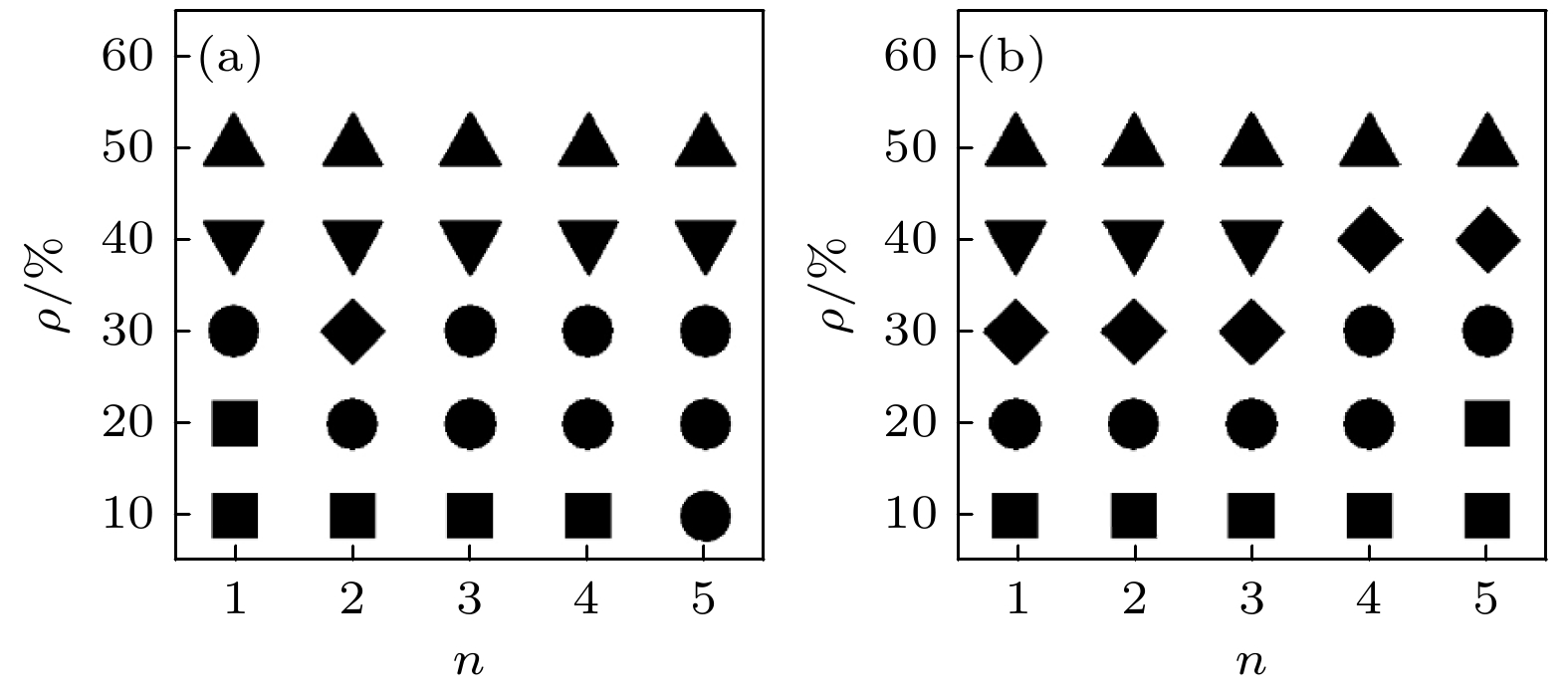












 下载:
下载:
